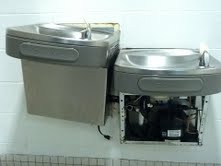From the following article:
Lead fears grow in Newark schools, but the problem isn’t new
HOW LONG HAS NEWARK KNOWN ABOUT LEAD IN THE WATER?
The district has been tackling the issue of lead coming from water sources, such as old sinks, in some schools since at least 2003, according to the federal Environmental Protection Agency.
John Martin, an EPA spokesman, said the agency found elevated levels in two of Newark’s schools that year. It offered the district help in addressing the problem. But he said Newark turned down the offer because it had its own lead remediation program in place.
Newark schools superintendent Christopher Cerf recently acknowledged that the district has been addressing issues of lead in water sources for more than a decade. For instance, the district had been replacing faucets and adding filters after taps showed higher levels of the toxin.
The district has only started to release test results to the public. But in each year since 2012, an outside laboratory has found elevated levels in the taps of some school buildings. For instance, 15 percent of the water samples taken during the 2014-15 school year showed amounts of lead that require action from school officials.
___
WHAT IS THE SCHOOL SYSTEM DOING TO ADDRESS THE PROBLEM?
Newark is working with the state Department of Environmental Protection as well as the EPA to tackle the issue. Efforts include testing every tap at every school. The district is also offering blood tests of as many as 17,000 kids who were potentially exposed.
In a press release, superintendent Cerf said last week’s test results prompted him to take action.
“By the time school opened Wednesday morning, we were shutting off all water fountains and other affected sites at any school that had received a positive reading,” Cerf said.
But Newark’s teachers union has criticized the state-controlled district for not taking such action in previous years. And Elise Pivnick, director of environmental health for Isles, a New Jersey-based environmental community group, added, “It’s really an old problem. There’s nothing new here. That water hasn’t changed in the last three years.”
As I noted in my post a few days ago, the water in Newark, New Jersey, has not changed. Nothing has changed there except suddenly the public became aware that Newark had elevated lead levels in the water in some of its schools. It appears Newark has known for some time the district needed to replace faucets and add filters “after taps showed higher levels of the toxin.”
Why new faucets? It’s not the faucets, it’s the pipes. Adding filters certainly seems like a good idea regardless, and I imagine that’s what the above article meant. They bought new faucets that had filters to take out the lead.
I hope they are on top of the water fountains. I am not so worried about hand washing as I am about those fountains. For one thing, fountains are an excuse to get out of class. Kids who drink little water at home may drink a great deal at school. They can’t go to the fridge for a drink they like better. They are served milk at lunch, which is healthy but not exactly a thirst-quencher. New health and nutrition guidelines have often eliminated the pop machines, or resulted in rules that allow pop purchases only after school.
On hot days and after gym, requests to go the fountain come regularly. Especially before my school added air-conditioning (only three years ago) I almost always let kids go during the high heat of fall and late spring. The line of water drinkers was trooping out there, one at a time. When temperatures were in the eighties and above in classrooms, administrators regularly reminded students to stay hydrated. Even in schools with cooling systems, some rooms simply run hot. Many cooling systems cannot begin to keep up with a wall of windows that faces sunside.
Eduhonesty: Are you working in an older school? Encourage your students to bring water bottles from home. I’d add those bottles to the list of expected supplies. Encourage parents to send water. I don’t know how much lead is too much lead, but I suspect Newark’s problem may be the tip of an iceberg. Teachers might even consider bringing in gallon jugs of water and little Dixie cups, especially in elementary school.

